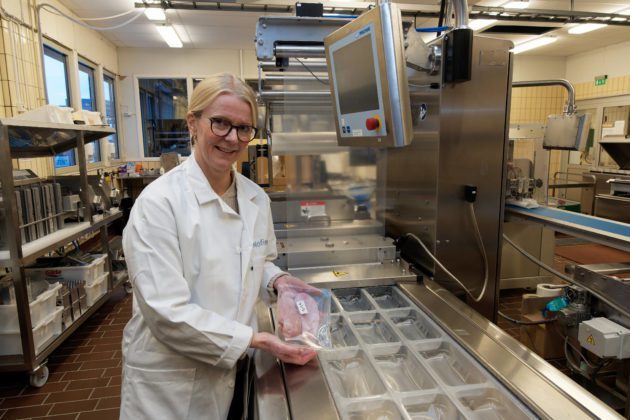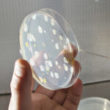Chicken fillets keep longer when the correct packaging method is used
Press release from Nofima

Chicken fillets keep longer when packed with CO₂ gas. The gas causes certain types of bacteria to grow poorly, while others don’t taste and smell as bad
More chicken fillets that can be used in tasty meals – and fewer that have to be thrown away because they have started to smell and taste bad. This can be the results of the research conducted by Anlaug Ådland Hansen and her colleagues at Nofima. The scientists have found out not only which bacteria cause the chicken to turn bad, but also what kind of odour they create.
Preventing food waste
“We have looked at how packaging can best protect food in order to maintain good quality and thus prevent food waste”, she summarises.
Skinless chicken fillet is a popular food product in Norway.
“There are various bacteria that limit the shelf life of chicken fillets. The increased knowledge means that we can control the quality to a greater extent. We want all food that is produced to be eaten”, says Anlaug Ådland Hansen.
Six common bacteria
The Nofima scientists have looked at six different bacteria that are commonly found on meat and that can also be found on fish. “In Norway, we pack this type of fillet product either with or without bacteria-inhibiting CO₂ gas. We have added these bacteria to the chicken and then stored it with and without CO₂”, she explains.
The chicken that has been tested was stored at refrigerator temperature – four degrees Celsius.
In addition to analysing the bacteria, she has received the help of professional noses to assess the quality of the chicken fillets. Nofima has its own sensory panel consisting of ten judges who are trained to assess smell and taste. In this case, they have smelled and determined when the meat smells among others/e.g., sour, fermented, pungent or rotten.
“What we saw is that all the types of bacteria grew when there was no CO₂ in the packaging”, she says. With CO₂, however, two of the bacteria did not multiply, while two others behaved the same as without CO₂ in the packaging.
These are the bacteria:
- Pseudomonas and Serratia did not produce bad odours at the bacteria levels analysed.
- Both Shewanella, Brochothrix, Carnobacterium and Hafnia all produced bad odours when packaging without CO₂ was used
- Shewanella and Brochothrix produced bad odours, but to a lesser extent when the fillets were packed using CO₂.
- Carnobacterium and Brochothrix both stood out regarding bad odours when the fillets were packed using CO₂.
Growth and odour
“Packing food without CO₂ quickly results in poorer quality than packing food with CO₂. We saw that when we packed using CO₂, only two of these six bacteria produced a clear negative odour at a certain bacterial level. We already knew that CO₂ inhibits bacterial growth. What is new here is that the gas not only extends shelf life because it results in lower bacterial growth, and we also see that the prevalence and intensity of the negative odour is reduced”, says Hansen.
In other words: Two of the bacteria multiply just as much as they normally do, but they do not produce as much bad odour.
“We need more knowledge about what actually limits shelf life. Many studies have been conducted that are similar to this one, but none of them study individual bacteria and the different odour characteristics they produce”, she says.
Identifying what smells
Previous studies have shown which bacteria are found on meat when its shelf life expires. However, they have not shown which bacteria have caused the meat to smell bad.
“We have now conducted a controlled study that gives us a better insight. We know which bacteria are able to grow under different packaging conditions, which ones produce negative odours and quality, and which ones we must try to prevent through various measures”, Hansen states.
The majority of food waste occurs at home in our kitchens. Food is kept in the fridge until it is not good anymore.
“Better control of quality and shelf life is very important if we are to achieve the goals of reducing food waste. All measures that help consumers to have the best possible product quality are very useful. This could also have a major impact on food waste in stores”, says Anlaug Ådland Hansen.
Facts about the packaging gas and the research
Carbon dioxide (CO2) is a gas that is commonly used in the packaging of perishable foods, where air is replaced with CO₂, and sometimes nitrogen is used as well (N₂). CO₂ has been used for decades based on its antibacterial effects. This helps the product maintain its freshness longer, and its shelf life increases when the product is stored at cool temperatures.
The research has been conducted as part of the FoodMicroPack and FutureFoodControl strategic programmes, funded by The Foundation for Research Levy on Agricultural Products. The trials were carried out in Nofima’s Food Packaging Pilot Plant, which is part of the Food Pilot Plant funded by the Research Council of Norway.
FutureFoodControl
Food safety, reduced food waste and sustainable packaging
2021 – 2024
FoodMicro-Pack
Safe and durable food, optimal packaging concepts and reduced food waste
2017 – 2020
Publication
Contact person

Anlaug Ådland Hansen
Scientist
+47 64 97 01 04
an***********@no****.no
Originally published on 9 February.
Announcements are published as a service to readers. The sender is responsible for all content.
Announcements for publication can be submitted to pr***********@ar**************.com.

